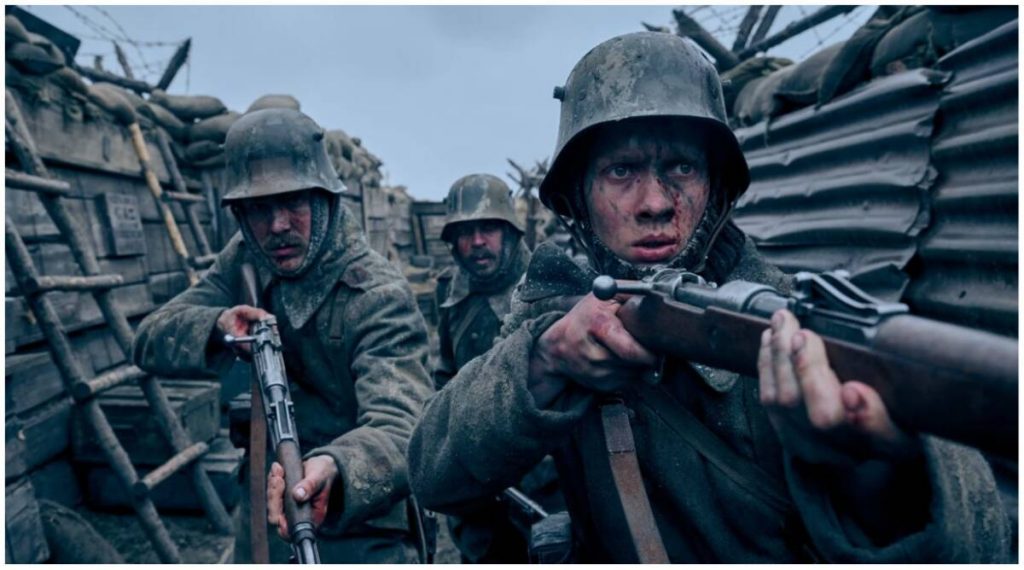All Quiet on the Western Front, a claustrophobic, depressing anti-war movie based on the acclaimed 1928 novel of the same name, is the most popular movie on Netflix right now.
With the aid of a bleak, anxiety-inducing soundscape, Netflix’s All Quiet on the Western Front delves deeply into the atrocities of World War One while following German teen soldier Paul Bäumer, who lies about his age to join the war effort alongside his schoolmates. This interpretation of Erich Maria Remarque’s novel All Quiet on the Western Front primarily ignores the issues surrounding the transition back to civilian life after a conflict while highlighting the cyclical nature of war.
Instead, the Netflix adaptation emphasizes how simple it was for the soldiers to lose their humanity, as well as how World War One’s events directly influenced World War Two through Germany’s imposition of sanctions as a result of the Versailles Treaty and the hatred instilled in a generation (best demonstrated by the farmer’s son and Kat’s tragic encounter in the woods). The distinctions between those in authority and those engaged in the war, however, are not very subtle when overzealous generals speak about fighting for honor and whine about day-old pastries while soldiers on both sides are battling in the mud for their lives. So how accurate is All Quiet on the Western Front on Netflix?
The original book’s author was a real-life German soldier who fought in World War One with the Imperial German Army. He began the book by outlining how the tale “is not meant to be an accusation or a confession, least of all an adventure, for those who stand before death know that it is not an adventure. It will just attempt to describe a generation of men who, although maybe evading [its] shells, were obliterated by the war.”
The novel was greatly influenced by Remarque’s time on the Western Front of World War One, focusing on the daily, terrible grind rather than Hollywood-ready deeds of heroism, even though it utilizes fictional characters and doesn’t go into detail about which battles are which. Due to its anti-war undertones, the novel was banned in Germany after the Nazis took power in 1933.
The muddy conditions of the trenches, the effectiveness of the Germans’ steel helmets to deflect flying shrapnel, the recycling of dead troops’ clothes and boots, and the execution of deserting soldiers are all authentic to what occurred. Similarly, during World War One, mustard gas was a very real, very deadly threat, and strategies like climbing “over the top” and attacking an enemy’s trench as well as the “creeping barrage” operation did all take place. But with the Hundred Days Offensive, in which the Allies drove the Axis forces back and largely liberated France and Belgium, trench combat had all but ended by March 1918.
The absolute horror as a wave of tanks and a string of Allied soldiers with flamethrowers come through the mist is one of the film’s most memorable sequences. Tanks were initially employed in 1916 at The Battle of the Somme and then sometimes throughout the conflict, with varying degrees of success being achieved by the versions developed by Britain, France, and Germany. When they operated, they could easily devastate an enemy’s line, but unskilled crews or technical difficulties frequently limited their effectiveness. The Axis countries also invented flamethrowers in 1915, and because of their capacity to flush out men from bunkers as well as the fear and panic they inflicted, they quickly became an indispensable tool in trench warfare.
Regarding the armistice, it was signed in a train car after much back and forth between the fluctuating German government and Matthias Erzberger, played by Daniel Brühl, and based on the real-life individual who led the German delegation. All Quiet on the Western Front certainly makes it appear considerably simpler than what transpired, but this is an anti-war film rather than a complex political mystery.
The closing scene, where a German officer decides on one final push before the truce becomes official, maybe the most tragic moment in a movie fueled by sadness. All Quiet on the Western Front repeatedly emphasizes how pointless war is, but these most recent casualties seem exceedingly terrible. These most recent fights did, however, take place. Officers wanted to be in the best possible position should battle resume as both sides were aware that the armistice might only be a brief cessation of hostilities while capitulation conditions were discussed (it was prolonged three times).
According to reports, several Allied artillery groups kept firing on German targets because the men didn’t want to carry along more ammo. On the penultimate day of action in World War One, 2,738 soldiers died and over 11,000 were wounded. In the last seconds of the movie, audiences are reminded that the first World War claimed the lives of close to 17 million people. No of whose side they were on, every soldier was a “bug in a box” with their trauma and life experiences. One of these viewpoints, utilized to convey the utter horror of the battle, is All Quiet on the Western Front.
